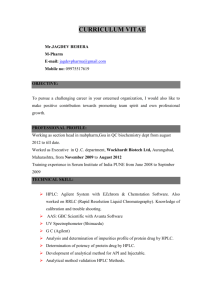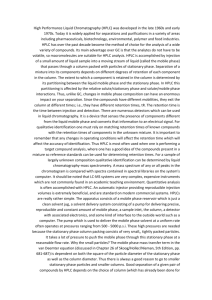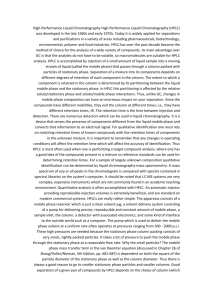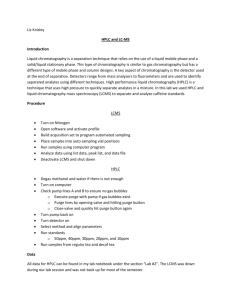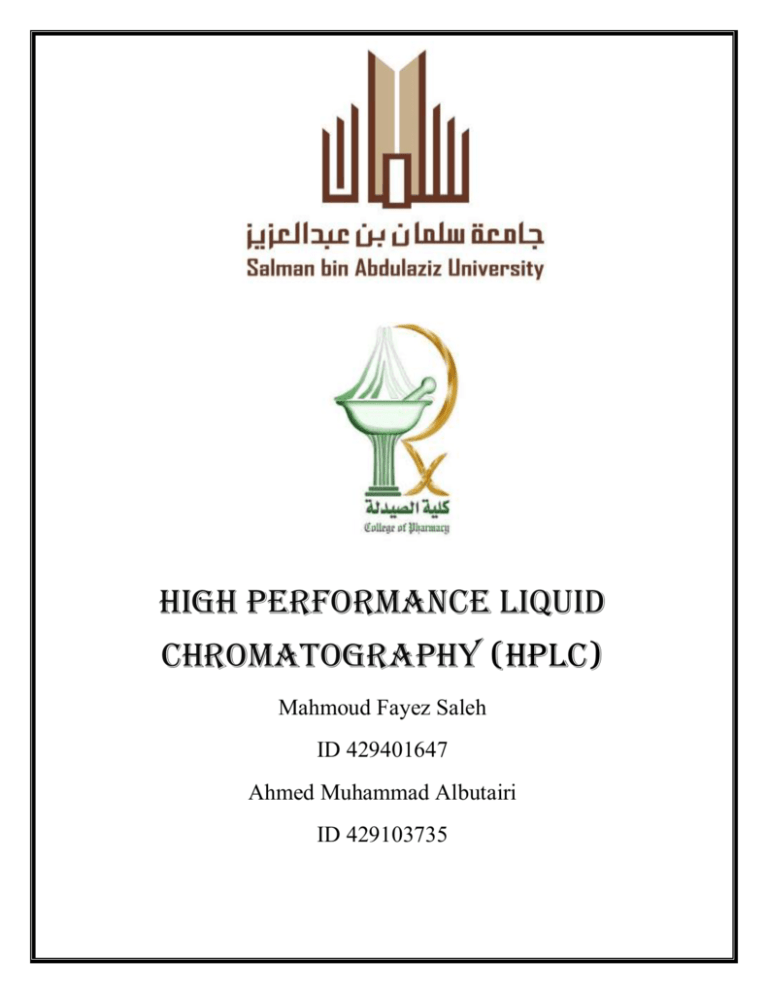
High Performance Liquid
Chromatography (HPLC)
Mahmoud Fayez Saleh
ID 429401647
Ahmed Muhammad Albutairi
ID 429103735
(HPLC)
High Performance Liquid Chromatography (HPLC) was developed in the late
1960s and early 1970s. Today it is widely applied for separations and purifications
in a variety of areas including pharmaceuticals, biotechnology, environmental,
polymer and food industries. HPLC has over the past decade become the method
of choice for the analysis of a wide variety of compounds. Its main advantage over
GC is that the analytes do not have to be volatile, so macromolecules are suitable
for HPLC analysis. HPLC is accomplished by injection of a small amount of liquid
sample into a moving stream of liquid (called the mobile phase) that passes
through a column packed with particles of stationary phase. Separation of a
mixture into its components depends on different degrees of retention of each
component in the column. The extent to which a component is retained in the
column is determined by its partitioning between the liquid mobile phase and the
stationary phase. In HPLC this partitioning is affected by the relative
solute/stationary phase and solute/mobile phase interactions. Thus, unlike GC,
changes in mobile phase composition can have an enormous impact on your
separation. Since the compounds have different mobilities, they exit the column at
different times; i.e., they have different retention times, tR. The retention time is
the time between injection and detection. There are numerous detectors which can
be used in liquid chromatography. It is a device that senses the presence of
components different from the liquid mobile phase and converts that information to
an electrical signal. For qualitative identification one must rely on matching
retention times of known compounds with the retention times of components in the
unknown mixture. It is important to remember that any changes in operating
conditions will affect the retention time which will affect the accuracy of
identification. Thus HPLC is most often used when one is performing a target
compound analysis, where one has a good idea of the compounds present in a
mixture so reference standards can be used for determining retention times. For a
sample of largely unknown composition qualitative identification can be
determined by liquid chromatography-mass spectrometry. A mass spectrum of any
or all peaks in the chromatogram is compared with spectra contained in spectral
libraries on the system's computer. It should be noted that LC-MS systems are very
complex, expensive instruments which are not commonly found in an academic
teaching environment. Quantitative analysis is often accomplished with HPLC. An
automatic injector providing reproducible injection volumes is extremely
beneficial and is standard on modern commercial systems. HPLCs are really rather
simple. The apparatus consists of a mobile phase reservoir which is just a clean
solvent jug, a solvent delivery system consisting of a pump for delivering precise,
reproducible and constant amount of mobile phase, a sample inlet, the column, a
detector with associated electronics, and some kind of interface to the outside
world such as a computer. The pump which is used to deliver the mobile phase
solvent at a uniform rate often operates at pressures ranging from 500 - 5000 p.s.i.
These high pressures are needed because the stationary phase column packing
consists of very small,, tightly packed particles. It takes a lot of pressure to push
the mobile phase through this stationary phase at a reasonable flow rate. Why the
small particles? The mobile phase mass transfer term in the van Deemter equation
is dependent on both the square of the particle diameter of the stationary phase as
well as the column diameter. Thus there is always a good reason to go to smaller
stationary phase particles and smaller columns. Good separation of a given pair of
compounds by HPLC depends on the choice of column (which has already been
done for you) and on the efficiency of the overall system. The relative position of
the various components in the sample on the chromatogram is affected by a solutesolvent type of interaction with the column substrate competing with a solutesolvent interaction with the mobile phase. Column efficiency is concerned with the
broadening of an initially compact band of solutes as it passes through the column.
The broadening is a result of column design and of column operating conditions.
For samples with a broad range of retention times, it is often desirable to employ
solvent programming, whereby the mobile phase composition is varied
continuously or in steps as the separation proceeds. This is the answer, in liquid
chromatography, to what is called The General Elution Problem. This is treated
chromatographic separations in general. Basically, the analysis of mixtures of
widely varying composition frequently leads to a very wide spread in retention
times. The longer the retention time, the broader the peak, so for those components
which take a long time to elute, detector sensitivity is diminished and analysis
times can be very long. With solvent programming, successively eluted substances
experience stronger solute-mobile phase interactions and so emerge from a column
more rapidly than they would under conditions in which the solvent was not
varied. So long as one does not experience peak overlap (i.e. resolution remains
tolerable), solvent programming gives a superior separation. HPLC is just one
type of liquid chromatography, meaning the mobile phase is a liquid. In this lab
you will use what is called reversed phase HPLC.
Reversed phase HPLC is the most common type of HPLC. What reversed phase
means is that the mobile phase is relatively polar, and the stationary phase is
relatively non-polar. Thus non-polar compounds will be more retained (i.e. have
longer retention times) than a polar compound. In normal phase HPLC, the mobile
phase is relatively non-polar and the stationary phase is relatively polar. Other
more general types of HPLC include partition, adsorption, ion-exchange, sizeexclusion, and thin-layer chromatography.
Many HPLC detectors available for universal & selective detection
1. Filter based UV-vis detector –Typically set at 254 nm using the most
prominent band in Hg spectrum – can also use 313, 365, 334 nm and other
lines as well.
2. Variable wavelength detectors – use continuum source like (D2 or H2) & a
monochromator, select any λ, less sensitive.
3. PDA - D2 or H2 source, disperse & focus on diode array, get complete
spectrum every 1 sec, powerful, expensive, less sensitive, lots of data
generated.
Cell for UV-VIS detector for HPLC - Low vol
Diode Array Detector
Fluorescence detector – normally fixed wavelength filter fluorometer excitation
filter & emission filter can be changed for particular λ of interest gives selectivity
based on:
- ability to exhibit fluorescence
- excitation wavelength
- emission wavelength
Variable λ monochromator based fluorescence detectors also available. Filter based
detectors usually more sensitive.
Refractive index detector (RI) - responds to nearly all solutes but has poor
sensitivity – detects changes in refractive index as sample passes through as long
as solute has different RI than solvent – analogous to TCD in GC.
Electrochemical Detection
• Amperometric – fix potential & measure current (i)
• Conductometric – measure conductivity
• Coulometric – fix potential & integrate i
• Voltammetric – vary potential & measure i
• Potentiometric – measure potential
Can use 2 or 3 electrode design with Pt or carbon electrodes (glassy C or C paste)
Electrochem. detector nearly universal.
Merits of the various detectors
Detector
UV/UV-VIS
detector
Optical
detection
2
Sensitivity
Merits
3
A wide variety of substances can be
detected that absorb light from 190 to
900 nm. Sensitivity depends strongly
on the component.
Diode array
detector (DAD,
PDA)
2
3
Fluorescence (FL)
detector
3
4
Differential
refractive index
(RI) detector
1
1
Evaporative light
scattering detector
(ELSD)
1
2
Conductivity
detector (CD)
Electrical
detection
Selectivity
2
3
Electrochemical
detector (ECD)
3
4
Corona® Charged
Aerosol Detector®
(Corona® CAD®)
1
3
4 = Excellent, 3 = Good, 2 = Moderate, 1 = Poor
A wide variety of substances can be
detected that absorb light from190 to
900 nm. Sensitivity depends strongly
on the component. The spectrum can
be confirmed for each component.
Components emitting fluorescence can
be detected selectively with high
sensitivity. This is often used for precolumn and post-column derivatization.
Any component that differs in
refractive index from the eluate can be
detected, despite its low sensitivity.
Cannot be used to perform gradient
analysis.
This detector atomizes the column
eluate, and detects the scattered light of
the resulting particulate components.
Non-UV-absorbing components are
detected with high sensitivity.
Ionized components are detected. This
detector is used mainly for ion
chromatography.
Electric currents are detected that are
generated by electric oxidationreduction reactions. Electrically active
components are detected with high
sensitivity.
This detector atomizes the column
eluate and electrically detects the
resulting
particulate
components
treated with corona discharge. UV-
nonabsorbing components can be
detected with sensitivity higher than
that of ELSD.
General
Separation of organic, inorganic, biological compounds, polymers, and
thermally labile compounds.
Qualitative and quantitative methods Common Specific Applications.
Quantitative/qualitiative analyses of amino acids, nucleic acids, proteins in
physiological samples.
Measuring levels of active drugs, synthetic byproducts, degradation products
in pharmaceuticals.
Measuring levels of hazardous compounds such as pesticides and
insecticides.
Monitoring environmental samples.
Purifying compounds from mixtures Limitations.
Qualitative analysis may be limited unless HPLC is interfaced with mass
spectrometry.
Resolution is limited with very complex samples Complementary or Related
Techniques.
Gas chromatography provides analyses volatile analytes with superior
resolution.
Supercritical fluid chromatography provides analyses of volatile, nonvolatile and thermally labile compounds.
Capillary
electrophoresis
provides
superior
analyses
in
many
biological/pharmaceutical applications.
Ion Chromatography provides analyses of ionic compounds, as does
capillary electrophoresis.
APPLICATION
The information that can be obtained using HPLC includes identification,
quantification, and resolution of a compound. Preparative HPLC refers to the
process of isolation and purification of compounds. This differs from analytical
HPLC, where the focus is to obtain information about the sample compound.
Chemical Separations It is based on the fact that certain compounds have
different migration rates given a particular column and mobile phase, the extent or
degree of separation is mostly determined by the choice of stationary phase and
mobile phase.
Purification: Purification is defined as the process of separating or extracting the
target compound from a mixture of compounds or contaminants. Each compound
showed a characteristic peak under certain chromatographic conditions. The
migration of the compounds and contaminants through the column need to differ
enough so that the pure desired compound can be collected or extracted without
incurring any other undesired compound.
Identification Generally assay of compounds are carried using HPLC. The
parameters of this assay should be such that a clean peak of the known sample is
observed from the chromatograph. The identifying peak should have a reasonable
retention time and should be well separated from extraneous peaks at the detection
levels which the assay will be performed.
Other applications of HPLC: Other applications of HPLC includes
Pharmaceutical applications:
• Tablet dissolution study of armaceutical dosages form.
• Shelf-life determinations of parmaceutical products
• Identification of active ingredients of dosage forms
• Pharmaceutical quality control
Environmental applications:
• Detection of phenolic compounds in Drinking Water
• Identification of diphenhydramine in sedimented samples
• Bio-monitoring of pollutant
Forensics:
• Quantification of the drug in biological samples.
• Identification of anabolic steroids in serum, urine, sweat, and hair
• Forensic analysis of textile dyes.
• Determination of cocaine and metabolites in blood
Clinical:
• Quantification of ions in human urine Analysis of antibiotics in blood plasma.
• Estimation of bilirubin and bilivirdin in blood plasma in case of hepatic disorders.
• Detection of endogenous neuropeptides in extracellular fluids of brain.
Food and Flavor:
• Ensuring the quality of soft drink and drinking water.
• Analysis of beer.
• Sugar analysis in fruit juices.
• Analysis of polycyclic compounds in vegetables.
• Trace analysis of military high explosives in agricultural crops.
References:
1. "Handbook of Instrumental Techniques for Analytical Chemistry" Frank
Settle, Editor: "High Performance Liquid Chromatography", Phyllis Brown,
Kathryn DeAntonois, Prentice Hall, 1997, pp. 147-164.
2. "Principles of Instrumental Analysis", 5th Edition. Skoog, Holler, Nieman,
Saunders College Publishing, 1998, pp. 673-697, 725-766.
3. http://www.interscience.be/promotiesites/hypersil/topics/promotiesites/hyper
sil/lcms2/biomolecules.pdf
4. Bergh J. J., Breytenbach, J. C. Stability-indicating High-performance
Liquid- chromatographic Analysis of Trimethoprim in Pharmaceuticals. J.
Chromatogr. 1987; 387: 528-531.
5. Stubbs C., Kanfer, I. Stability-indi- cating High-performance Liquidchromato- graphic Assay of Erythromycin Estolate in Pharmaceutical
Dosage Forms. Int. J. Pharm. 1990; 3(2): 113-119.
6. MacNeil L., Rice J. J., Muhammad N. Lauback R. G. Stability-indicating
Liquid-chromatographic Determination of Cefapirin, Desacetylcefapirin and
Cefapirin Lactone in Sodium Cefapirin Bulk and Injectable Formulations. J.
Chromatogr. 1986; 361: 285-290.
7. Bounine J. P., Tardif B., Beltran P. Mazzo D. J. High-performance Liquid© 2009, JGPT. All Rights Reserved. 25 Bansal V. et al., Journal of Global
Pharma Technology. 2010; 2(5): 22-26.
8. chromatographic Stability-indicating Determination of Zopiclone in Tablets.
J. Chromatogr. 1994; 677(1): 87-93.
9. Lauback R. G., Rice J. J., Bleiberg B., Muhammad N., Hanna, S. A. 1984.
Specific High-performance Liquid-chromato- graphic Determination of
Ampicillin in Bulks, Injectables, Capsules and Oral Suspensions by
Reversed-phase Ion-pair Chromatography. J. Liq. Chromatogr. 1984; 7(6):
1243-1265.
10. Wiklund A E., Dag B., Brita S. Toxicity evaluation by using intact
sediments and sediment extracts. Marine Pollution Bulletin (2005); 50(6):
660-667.
11. Kwok Y. C., Hsieh D. P. H., Wong P. K. Toxicity identification evaluation
(TIE) of pore water of contaminated marine sediments collected from Hong
Kong waters. Marine Pollution Bulletin. 2005; 51(8-12): 1085-1091.
12. Hongxia Yu., Jing C., Cui Y., Shang H., Ding Z., Jin H. Application of
toxicity identification evaluation procedures on wastewaters and sludge from
a municipal sewage treatment works with industrial inputs. Ecotoxicology
and Environmental Safety. 2004; 57(3): 426-430.
13. Ayerton J. Assay of ceftazidime in biological fluids using high-pressure
liquid chromatography. J. Antimicrob. Chemother. 1981; 8: 227-231.
14. Bowden R.E., Madsen P.O. High- pressure liquid chromatographic assay of
sulbactam in plasma, urine and tissue. Antimicrob. Agents Chemother. 1986;
30: 31-233.
15. Haginaka J., Yasuda H., Uno T., Nkagawa T. Alkaline degradation and
determination
by
high-performance
by
high-performance
liquid
chromatography. Chem. Pharm. Bull. 1984; 32: 2752-2758
16. Fredj G., Paillet Aussel M. F., Brouard A., Barreteau H., Divine C., Micaud
M. Determination of sulbactam in biological fluids by high-performance
liquid chromatography. J. Chromatogr. 1986; 383: 218-222.
17. Rodenas V., Garcia M.S., Sanchez-Pedreno C., Albero M.I. Flow-injection
spectrophotometric determination of frusemide or sulphathiazole in
pharmaceuticals. J. Pharm. Biomed. Anal. 1997; 15: 1687-1693.
18. Shah A.J., Adlard M.W., Stride J.D. A sensitive assay for clavulanic acid
and
sulbactam
in
biological
fluids
by
high-performance
liquid
chromatography and precolumn derivatization. J. Pharm. Biomed. Anal.
1990; 5: 437-443.
19. Abidi S.L. High-performance liquid chromatography of phosphatidic acids
and related polar lipids. J.Chromatogr. 1991; 587: 193-203.
20. Christie W.W., Gill S., Nordbäck J., Itabashi Y., Sanda S., Slabas A.R. New
procedures for rapid screening of leaf lipid components from Arabidopsis.
Phytochemical Anal. 1998; 9: 53-57.
21."Introduction to Modern Liquid Chromatography" by L.R. Snyder and J.J.
Kirkland, 2nd Edition. John Wiley & Sons, 1979. LC-GC Magazine.
Advanstar Communications.
www.chromatographyonline.com
http://www.hitachi-hitec.com/global/science/lc/lc_basic_7.html
HPLC Links
A general treatment of chromatography including an overview of plate and rate
theory.
http://ull.chemistry.uakron.edu/analytical/Chromatography/
Tutorials on molecular spectroscopy and chromatography.
http://www.shu.ac.uk/schools/sci/chem/tutorials/




